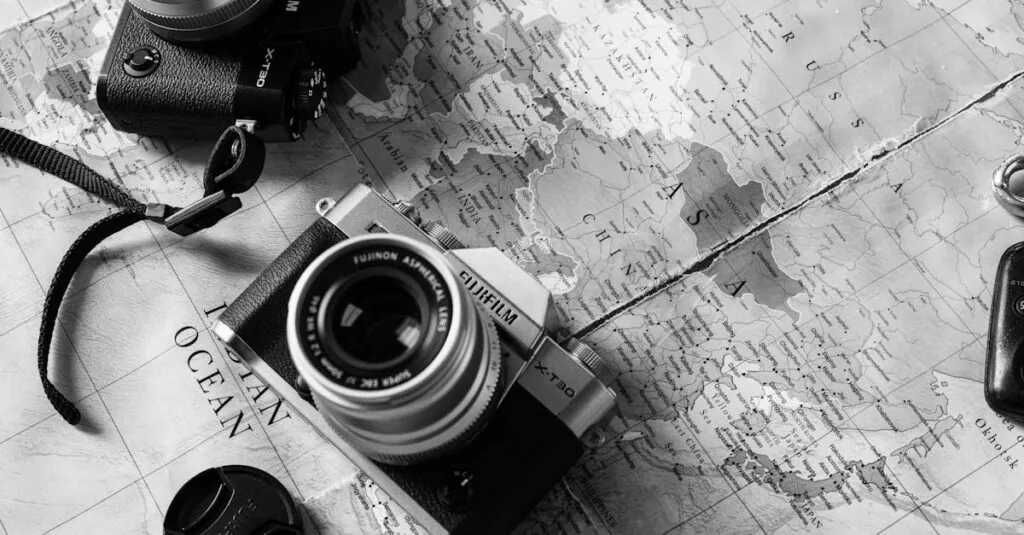Table of Contents
ToggleIn a world that’s more connected than ever, documenting foreign culture has become the passport to understanding our global neighbors. Imagine diving into the vibrant festivals of India or savoring the nuanced flavors of Italian cuisine—all from the comfort of your couch. It’s like a travel show but without the jet lag or questionable airplane food.
Capturing the essence of different cultures isn’t just about snapping pictures; it’s about weaving stories that resonate. Whether it’s quirky traditions or the latest dance craze that’s sweeping the streets, these cultural snapshots can spark curiosity and foster appreciation. So grab your camera and your sense of humor, because documenting foreign culture isn’t just an adventure; it’s an invitation to explore the world in all its delightful chaos.
Importance Of Documenting Foreign Culture
Documenting foreign culture plays a crucial role in fostering understanding and appreciation for the world’s diversity. Engaging with different cultures enhances global connections and broadens perspectives.
Understanding Cultural Diversity
Cultural diversity refers to the variety of human societies and cultures within a specific region or globally. Embracing this diversity fosters tolerance and respect among different communities. Exposure to unique customs, traditions, and languages offers insights into various ways of life, enriching one’s worldview. Every documented culture provides a glimpse into the historical contexts that shape societal values. In turn, this understanding encourages empathy and cooperation in an increasingly interconnected world.
Preserving Heritage And Traditions
Preserving heritage and traditions prevents the loss of invaluable cultural identities. Documenting rituals, art forms, and folklore maintains a culture’s historical narrative. Engagement in oral histories and written records safeguards practices that could fade with time. Such preservation efforts allow future generations to connect with their roots. Acknowledging every tradition contributes to cultural continuity, supporting community pride and identity. By sharing these treasures through documentation, communities remain vibrant and resilient in the face of globalization.
Methods For Documenting Foreign Culture
Documenting foreign cultures involves various methods that capture their essence and significance. These techniques help preserve traditions and foster understanding across global communities.
Ethnographic Research
Ethnographic research immerses individuals in a culture, providing deep insights through firsthand experiences. Observers interact with community members, participating in day-to-day activities and rituals. This approach emphasizes understanding social dynamics and cultural practices in natural settings. Researchers can gather data on values, beliefs, and social norms. Collecting this information aids in painting a comprehensive picture of a culture’s identity. By analyzing behaviors and interactions within a community, ethnographers reveal layers that photographs alone miss. Such documentation becomes invaluable for future scholarly work and cultural preservation.
Interviews And Oral Histories
Interviews and oral histories capture personal narratives that reflect cultural heritage. Engaging in conversations with community members enables a deep connection to individual stories and experiences. These dialogues reveal customs, traditions, and personal interpretations of a culture’s meaning. Recording these narratives brings history to life, allowing for a richer understanding of social contexts. Participants often share their perspectives, leading to a mosaic of voices that enriches cultural documentation. This method is crucial for preserving knowledge that might otherwise be lost, promoting intergenerational connection and learning.
Challenges In Documenting Foreign Culture
Documenting foreign cultures presents significant challenges that require careful navigation. These challenges encompass ethical considerations and language barriers.
Ethical Considerations
Ethical concerns arise when representing foreign cultures. Respect for cultural practices and beliefs plays a crucial role. Researchers must approach communities with sensitivity, ensuring that documentation accurately reflects the culture without exploitation. Gaining informed consent is essential as it affirms participants’ rights. Privileged perspectives can risk misrepresentation, thus emphasizing the need for inclusive storytelling. Cultivating trust within communities fosters authentic relationships, ultimately leading to richer documentation. Representation extends beyond mere observation; advocates aim to amplify the voices and narratives of all involved.
Language Barriers And Misinterpretations
Language differences pose significant hurdles in documenting culture. misinterpretations can easily occur when translating nuanced expressions. Accurate communication is vital for capturing cultural richness. Engaging bilingual speakers or translators ensures clarity in conversations and preserves meaning. Understanding context matters, as phrases may hold different significance in various cultures. Misunderstandings can skew perceptions, leading to inaccuracies in representation. Taking time to learn basic phrases can improve interactions and establish rapport. Building connections strengthens cultural appreciation and enhances the documentation process.
Tools And Technologies For Documentation
Documenting foreign culture relies heavily on modern tools and technologies that enhance the understanding and sharing of cultural experiences. Digital platforms enable individuals to capture and disseminate these rich narratives globally.
Digital Media And Photography
Digital media plays a crucial role in documenting foreign cultures. Cameras and smartphones allow for high-quality photos and videos that capture vibrant traditions and daily lives. Social media platforms, such as Instagram and YouTube, offer channels for sharing these visual stories with a broader audience. Editing software enhances imagery, making it visually appealing while retaining authentic cultural elements. Drones can provide unique aerial perspectives that showcase landscapes, rituals, and festivals. Additionally, online archives help preserve cultural artifacts and experiences, ensuring they remain accessible as part of a community’s heritage.
Writing And Storytelling Techniques
Writing serves as a powerful method to document cultural narratives. Journalistic practices allow for detailed exploration of local customs and historical contexts. Creative writing techniques engage readers, drawing them into personal stories and experiences. First-person narratives reflect individual perspectives while promoting emotional connections. Incorporating local languages and idioms adds authenticity, enriching the texture of the documentation. Additionally, blogs and articles can host interviews that spotlight community members and their invaluable stories. Capturing these voices fosters a deeper appreciation of cultural nuances and encourages global dialogue.
Documenting foreign culture is a vital endeavor that nurtures understanding and appreciation of global diversity. By engaging deeply with traditions and narratives, individuals can bridge cultural gaps and foster connections that transcend geographical boundaries. This practice not only preserves heritage but also enriches personal experiences and community pride.
As technology continues to evolve, the opportunities for capturing and sharing cultural stories expand. Embracing ethical considerations and ensuring respectful representation will enhance the authenticity of these narratives. Ultimately, the journey of documenting foreign cultures invites everyone to explore the richness of human experience and cultivate a more interconnected world.







